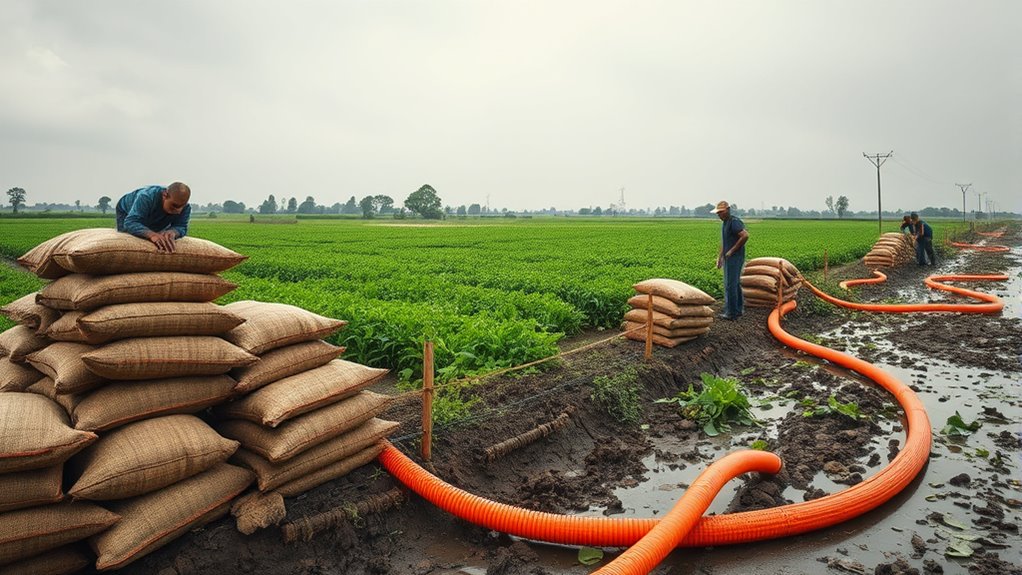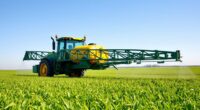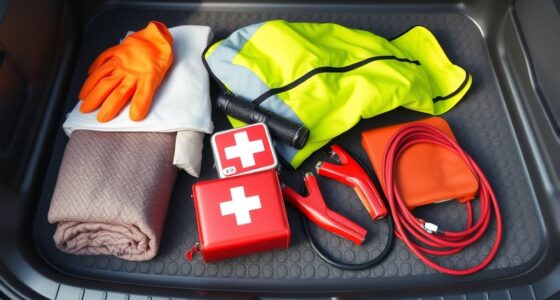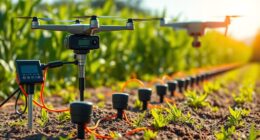To prepare your farm for floods with sandbags and drainage, assess flood risks by checking proximity to water sources and historical patterns. Plan your defense by selecting sturdy sandbags like polypropylene and placing them in stable, staggered stacks at vulnerable points. Install proper drainage channels to direct water away from structures and crops. Regularly inspect barriers and drainage systems to keep them effective. Stay prepared for potential emergencies—more tips follow to enhance your flood defense plan.
Key Takeaways
- Assess flood risk areas and identify vulnerable structures to prioritize sandbag placement and drainage improvements.
- Select durable, properly sized sandbags and position them in staggered, overlapping layers to create effective barriers.
- Enhance drainage systems by clearing blockages, increasing capacity, and directing water away from critical zones.
- Establish clear procedures for sandbag deployment, regular inspections, and quick response during heavy rainfall.
- Prepare emergency supplies and educate farm staff on flood response and maintenance of barriers and drainage systems.
Assessing Your Farm’s Flood Risks
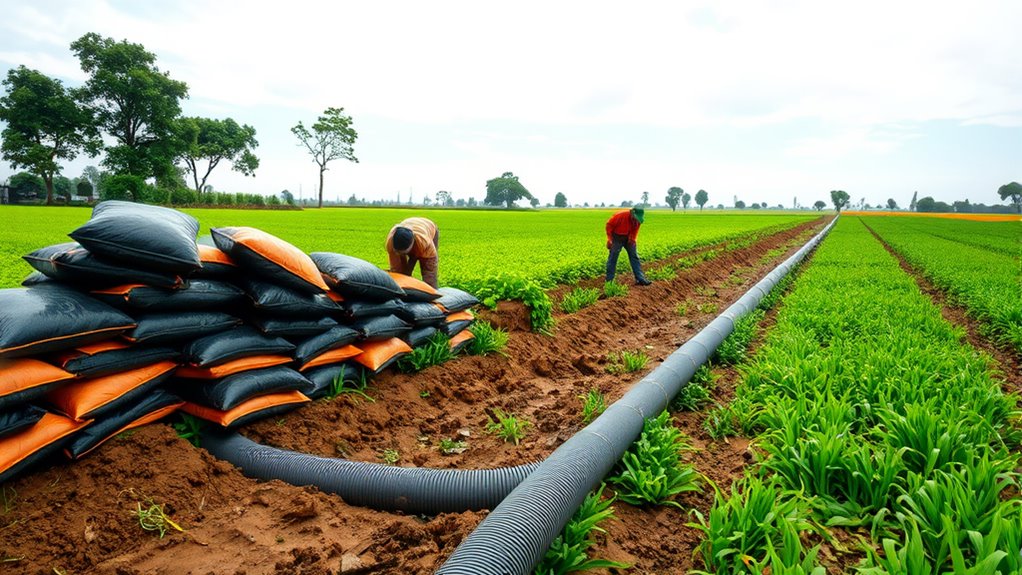
Have you ever considered how vulnerable your farm is to flooding? To protect your crops and livestock, you need to understand your specific risks. Start by examining your farm’s location—are you near rivers, floodplains, or low-lying areas? Check historical flood records for your region to identify patterns or frequent flood events. Consider the drainage systems currently in place and how well they handle heavy rain. Evaluate the soil type; saturated or poorly draining soil increases flood risk. Also, analyze weather forecasts and climate trends that might influence future flooding. By thoroughly appraising these factors, you gain a clear picture of your farm’s vulnerabilities, enabling you to prioritize areas needing protection and plan more effectively for flood preparedness. Additionally, understanding your area’s flood risks can help you determine if online resources or local experts are available to assist with early warning systems and mitigation strategies.
Planning Your Flood Defense Strategy
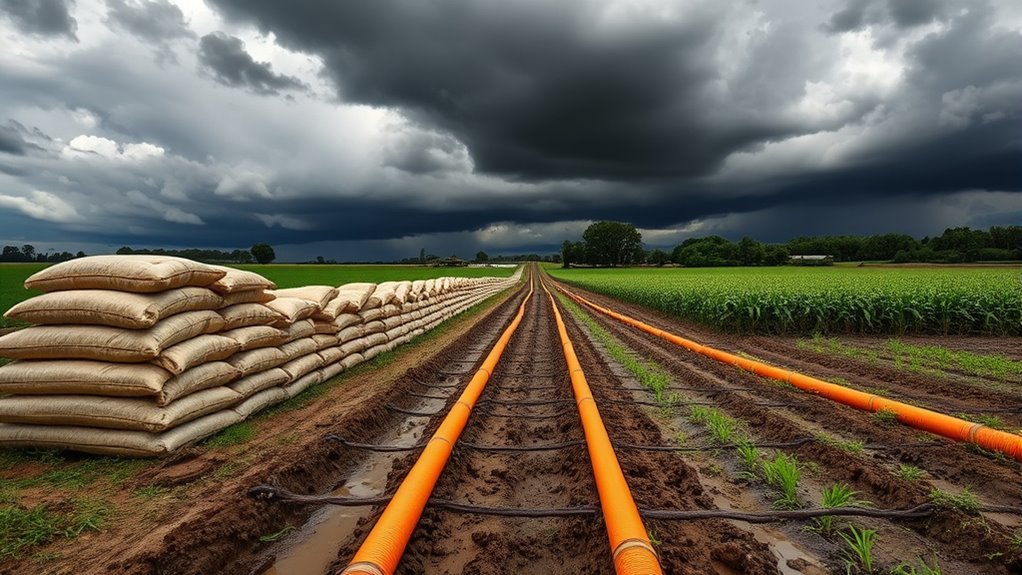
After evaluating your farm’s flood risks, the next step is to develop a thorough flood defense strategy. Begin by identifying key areas vulnerable to flooding and prioritize protection for structures, crops, and livestock. Create a timeline for pre-flood preparations, such as installing barriers or improving drainage systems. Determine how much sandbag supply you’ll need and plan logistics for quick deployment. Consider the placement of barriers to direct water away from critical zones and ensure access points remain open. Establish clear roles and responsibilities for everyone involved so that actions are coordinated and efficient. Regularly review and update your plan based on changing weather patterns or new risks. Incorporating insights from local beach communities can provide valuable ideas for effective waterfront defenses. A well-thought-out strategy helps you act swiftly, minimizing damage and safeguarding your farm’s future.
Selecting the Right Types of Sandbags
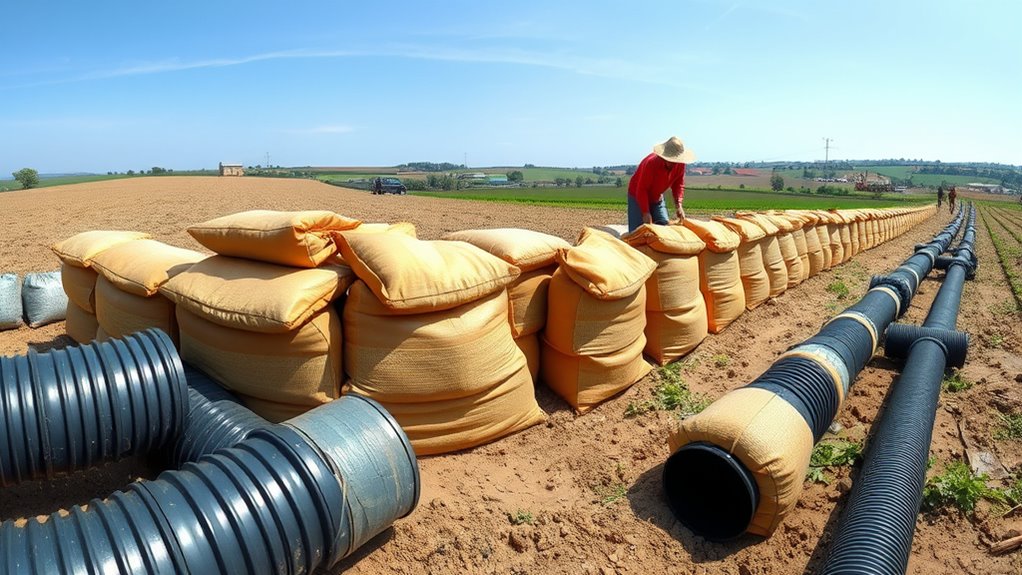
Choosing the right type of sandbags is essential to guarantee your flood defenses are effective and durable. You’ll want bags made from sturdy materials like burlap or polypropylene, which resist tearing and weathering. Burlap bags are biodegradable and breathable, making them ideal for short-term use, but they may degrade faster in wet conditions. Polypropylene bags are more resistant to moisture and last longer, providing better protection during prolonged floods. Consider weight and size as well—larger, heavier bags are easier to stack securely, but smaller bags are more manageable for detailed placement. Additionally, double-check that the bags are sealed tightly to prevent leaks. Selecting the appropriate sandbags ensures your flood barriers stay in place and do their job when it matters most. Proper material selection directly influences the contrast ratio and overall effectiveness of your flood defenses.
Proper Techniques for Sandbag Placement
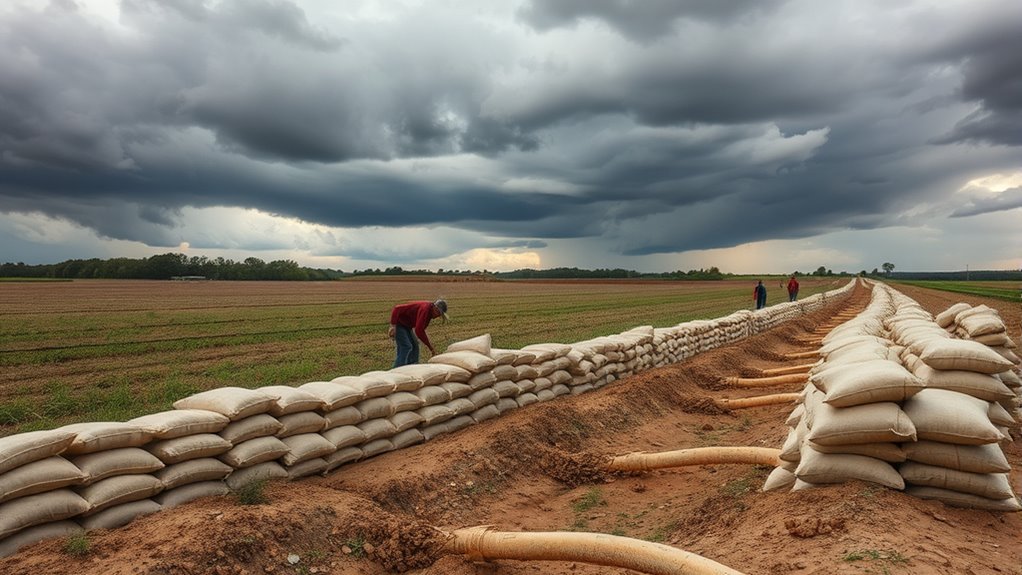
To effectively prevent floodwaters from breaching your defenses, you need to place sandbags strategically. Start by stacking them in a staggered pattern, similar to bricks, to create a strong barrier. Next, verify the bags are snugly fitted together with no gaps, so water can’t seep through. Place the first row directly on the ground, slightly overlapping the surface. Then, add subsequent layers with each row offset to increase stability. Finally, reinforce critical points, such as corners or entrances, with additional bags or crumpled sandbags to seal gaps. Proper placement also involves maintaining a slight downward slope away from the protected area, directing water outward and preventing pooling. Regularly assessing and adjusting your sandbag line enhances effectiveness and resilience against floodwaters, especially when combined with other flood prevention measures.
Installing Effective Drainage Systems
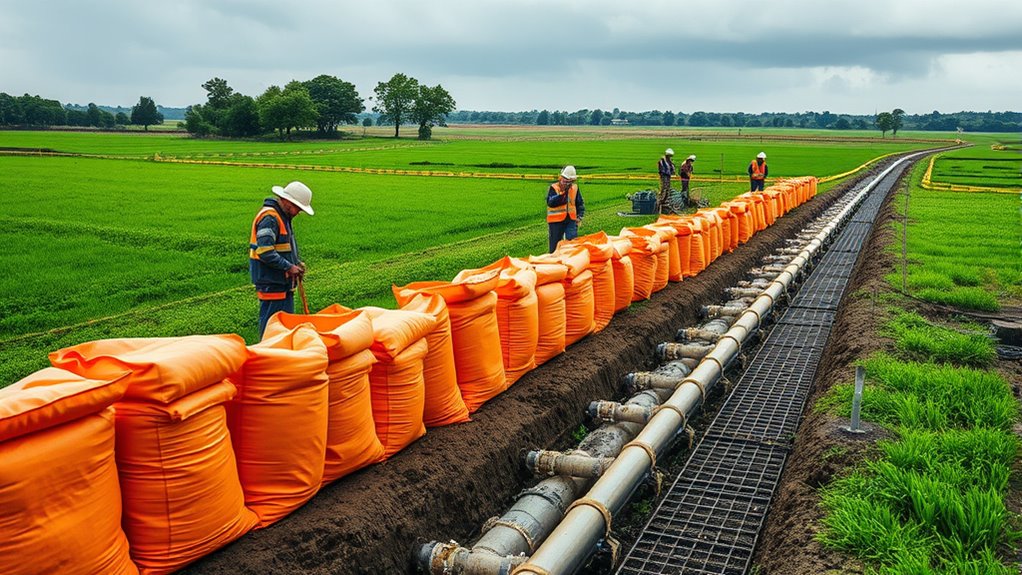
Have you considered how installing effective drainage systems can substantially reduce flood damage on your farm? Proper drainage directs excess water away from vulnerable areas, preventing pooling and soil erosion. Start by evaluating your land to identify low spots where water tends to collect. Then, choose the right drainage solutions, such as French drains, surface ditches, or subsurface pipes, tailored to your farm’s layout. Ensure that these systems have a clear outlet to steer water safely away. Regularly inspect and clear any blockages to keep water flowing smoothly. Installing effective drainage not only minimizes flood risk but also improves soil health and crop productivity. Additionally, incorporating drainage systems that are suitable for your specific terrain can provide long-term protection against flooding. Prioritizing drainage now helps safeguard your farm’s future against unexpected floods.
Maintaining and Monitoring Flood Barriers
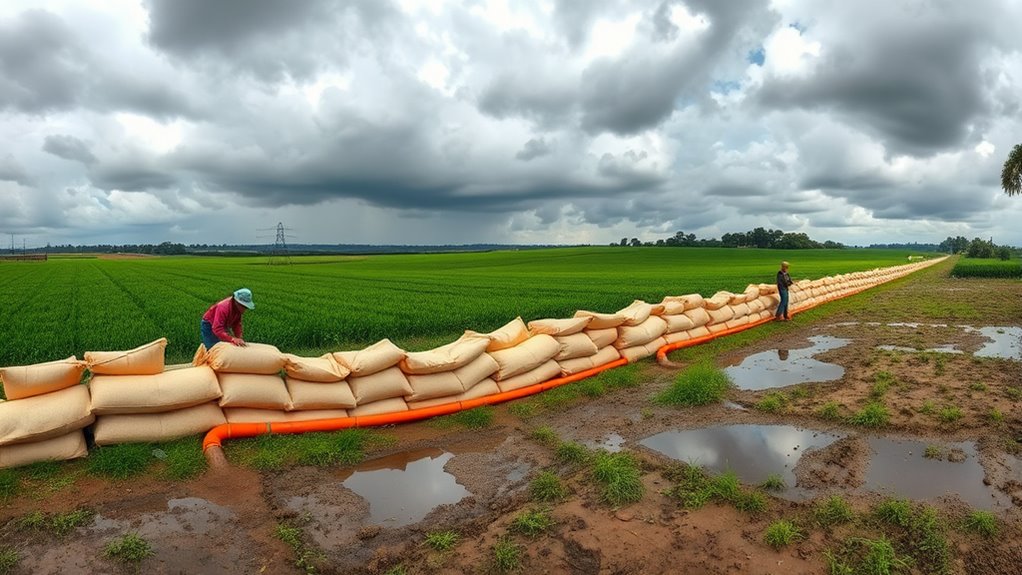
Maintaining and monitoring flood barriers is crucial to guarantee they effectively protect your farm during heavy rains. Regular inspections identify damage or weaknesses before a flood occurs. You should:
- Check for tears, holes, or gaps in sandbags and barriers.
- Ensure barriers are securely anchored and properly aligned.
- Clear debris or obstructions that could compromise the barrier’s integrity.
- Test drainage points to confirm water flows away from barriers smoothly.
- Stay informed about flood risk management strategies that can enhance your barrier’s effectiveness.
Consistent monitoring during rainstorms helps catch issues early. It’s also imperative to document inspections and repairs for future reference. Proper maintenance guarantees barrier durability and reliability, reducing flood risk. Staying proactive ensures your farm remains protected when heavy rains hit.
Preparing Emergency Supplies and Evacuation Plans
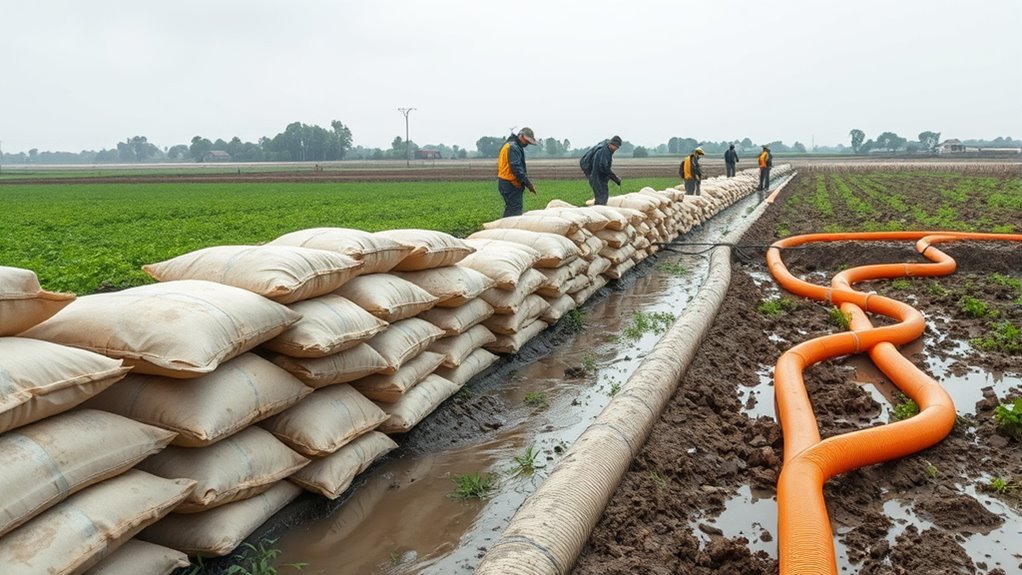
After ensuring your flood barriers are in good shape, it’s time to focus on preparedness. You should assemble an emergency kit with essentials like non-perishable food, clean water, medications, flashlights, batteries, and first aid supplies. Keep these items in a waterproof container and easily accessible location. Develop and rehearse an evacuation plan with your team, identifying primary and secondary routes and safe shelters. Make sure everyone knows how to shut off utilities like gas, water, and electricity to prevent damage or accidents. Keep important documents, such as farm records and identification, in a waterproof bag. Regularly review and update your plans, ensuring all staff understand their roles. Familiarize yourself with paint sprayer maintenance to ensure equipment is ready for any emergency use. Being prepared minimizes chaos and helps protect your farm, animals, and personnel during a flood.
Post-Flood Inspection and Recovery Procedures
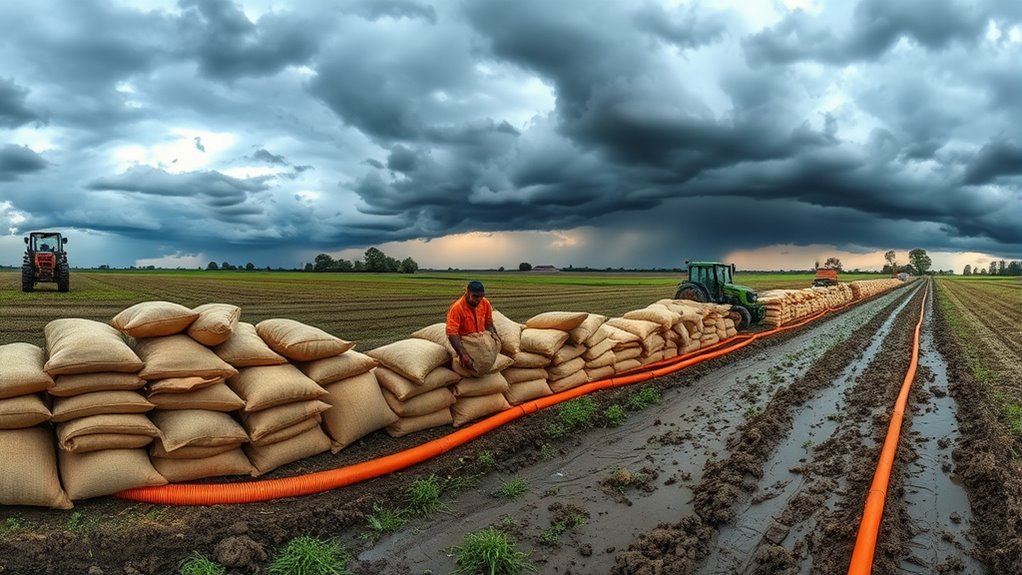
Once the floodwaters recede, it’s crucial to conduct a thorough inspection of your farm to assess damage and identify hazards. Start by checking buildings for structural damage, such as weakened walls or foundation issues. Next, evaluate soil and crop health, looking for erosion, contamination, or drowned plants. Inspect irrigation systems, drainage, and fencing to ensure they haven’t been compromised. Finally, identify safety hazards like submerged debris, exposed wiring, or contaminated water sources. Incorporating water quality testing can help determine if your water sources have been affected by floodwaters, ensuring safe irrigation and livestock use. To streamline recovery, focus on these key steps: 1. Document damage with photos and notes. 2. Remove debris to prevent injuries and pests. 3. Disinfect affected areas to prevent disease spread. 4. Plan repairs and soil remediation to restore productivity.
Frequently Asked Questions
How Can Weather Forecasts Improve Flood Preparedness on Farms?
Weather forecasts improve your flood preparedness by giving you early warnings, so you can act quickly. With accurate predictions, you can move livestock, protect crops, and reinforce barriers like sandbags before the flood hits. You’ll also plan irrigation and drainage better, reducing damage. Staying updated with forecasts helps you prioritize actions, ensuring your farm is as prepared as possible to minimize flood impact and protect your livelihood.
What Are Cost-Effective Methods for Long-Term Flood Protection?
Think of long-term flood protection as building a sturdy dam to hold back rising waters. You can invest in natural barriers like planting deep-rooted native grasses and trees, which strengthen soil and reduce runoff. Additionally, installing permeable pavements allows water to seep into the ground, lowering flood risk. These methods are cost-effective, sustainable, and help your farm withstand future floods without draining your finances.
How to Train Farm Staff in Flood Response Procedures?
You should start by organizing hands-on training sessions that cover flood response procedures, including evacuation routes, safety protocols, and equipment use. Guarantee your staff understands how to set up sandbags and activate drainage systems. Regularly conduct drills to reinforce these skills and identify any gaps. Keep training materials accessible and update them as needed. Encourage open communication so everyone feels confident and prepared to respond swiftly during a flood event.
Are There Legal Regulations for Flood Defenses on Farms?
Yes, there are legal regulations you must follow for flood defenses on farms. You need to comply with local, regional, and national laws that govern environmental protection and land use. You might require permits for constructing barriers or drainage systems. It’s essential that you verify with your local authorities or environmental agencies to ensure your flood defenses meet all legal standards and do not harm surrounding ecosystems.
How Can Technology Enhance Flood Monitoring and Alerts?
Technology greatly improves flood monitoring and alerts by providing real-time data through sensors and satellite imagery. You can use weather apps and custom alert systems to stay informed about potential floods. Drones and IoT devices help you monitor water levels and drainage conditions remotely. These tools enable you to respond quickly, protecting your farm from flood damage and minimizing disruption to your operations.
Conclusion
By staying vigilant and prepared, you can protect your farm from floods like a seasoned knight guarding his castle. Regularly assess risks, use the right sandbags and drainage, and keep your defenses in top shape. Remember, a well-prepared farm can weather any storm — even if it’s as fierce as a dragon’s fire. So, don’t wait for a flood to catch you off guard; take action now and keep your farm safe and sound.

